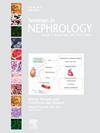血浆中性粒细胞明胶酶相关脂钙蛋白作为严重恶性疟原虫疟疾肾损伤的生物标志物和缺氧脑损伤的潜在预测因子:来自印度的见解
IF 3.5
3区 医学
Q2 UROLOGY & NEPHROLOGY
引用次数: 0
摘要
严重疟疾与肾和脑损伤有关,但联系这两种并发症的潜在机制仍未得到充分研究。我们调查了严重恶性疟原虫疟疾的印度成人和儿童队列中肾脏和脑损伤之间的关系。我们发现急性肾损伤在成人(64.4%)和儿童(71.4%)中都很普遍。我们还发现,结构性肾损伤生物标志物中性粒细胞明胶酶相关脂钙蛋白(NGAL)的血浆水平与急性肾损伤严重程度密切相关(P < 0.0001),与脑疟疾全脑磁共振成像表观扩散系数值负相关(r = -0.6, 95%置信区间,-0.8至-0.3)。低的表观扩散系数值表明细胞毒性水肿,这是一种由寄生虫隔离和炎症介导的缺氧脑损伤。严重的细胞毒性水肿已被证明与严重疟疾死亡率增加有关。在我们的队列中,NGAL水平高(>300 ng/mL)的患者发生这种形式脑损伤的风险高出5.5倍(患病率风险比5.5,95%置信区间,2.3-13.2)。这些结果表明,血浆NGAL可能在结构性肾损伤中发挥关键作用,并可作为严重疟疾背景下缺氧脑损伤的预测标志物。本文章由计算机程序翻译,如有差异,请以英文原文为准。
Plasma Neutrophil Gelatinase-Associated Lipocalin as a Biomarker of Kidney Injury and Potential Predictor of Hypoxic Brain Injury in Severe Plasmodium falciparum Malaria: Insights From India
Severe malaria is associated with kidney and brain injury, yet potential mechanisms linking both complications remain understudied. We investigated the associations between kidney and brain injuries in a cohort of Indian adults and children with severe Plasmodium falciparum malaria. We found that acute kidney injury was prevalent in both adults (64.4%) and children (71.4%). We also found that plasma levels of the structural kidney injury biomarker neutrophil gelatinase-associated lipocalin (NGAL) were strongly associated with acute kidney injury severity (P < .0001) and negatively correlated with whole brain magnetic resonance imaging apparent diffusion coefficient values in cerebral malaria (r = –0.6, 95% confidence interval, –0.8 to –0.3). Low apparent diffusion coefficient values indicate cytotoxic edema, a form of hypoxic brain injury mediated by parasite sequestration and inflammation. Severe cytotoxic edema has been shown to be associated with increased mortality in severe malaria. In our cohort, there was a 5.5-fold greater risk of this form of brain injury (prevalence risk ratio, 5.5, 95% confidence interval, 2.3-13.2) in patients with high NGAL levels (>300 ng/mL). These results suggest that plasma NGAL may play a critical role in structural kidney injury and could serve as a predictive marker for hypoxic brain injury in the context of severe malaria.
求助全文
通过发布文献求助,成功后即可免费获取论文全文。
去求助
来源期刊

Seminars in nephrology
医学-泌尿学与肾脏学
CiteScore
5.60
自引率
0.00%
发文量
27
审稿时长
6-12 weeks
期刊介绍:
Seminars in Nephrology is a timely source for the publication of new concepts and research findings relevant to the clinical practice of nephrology. Each issue is an organized compendium of practical information that serves as a lasting reference for nephrologists, internists and physicians in training.
 求助内容:
求助内容: 应助结果提醒方式:
应助结果提醒方式:


